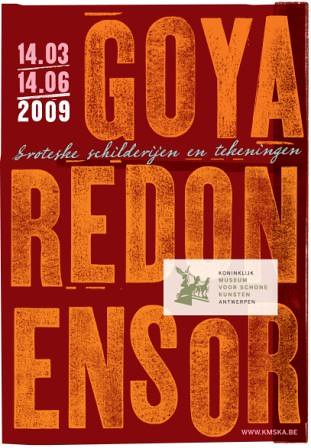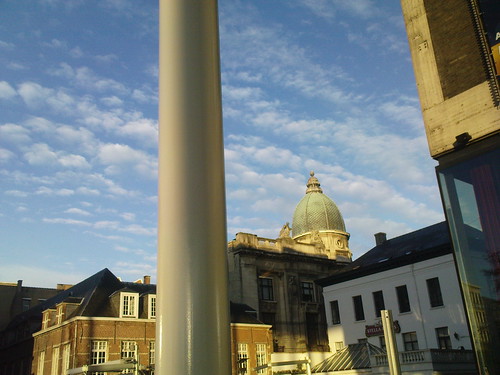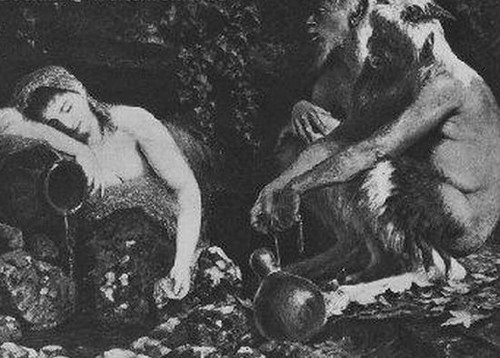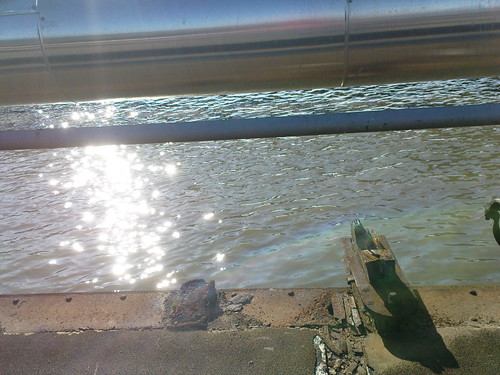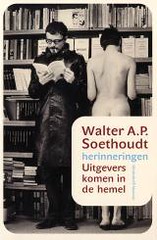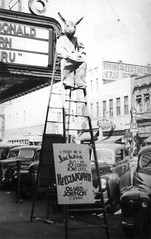If you live in Antwerp and are into Dutch lit, there is lovingly put together expo on Remco Campert (born 1929) at Antiquariaat Demian. The photo is a detail of the shop window this afternoon.
Category Archives: Antwerpen
Goya, Redon, Ensor. Grotesque paintings and drawings
Goya, Redon, Ensor. Grotesque paintings and drawings is a current exhibition at the Royal Museum of Fine Arts in Antwerp.
Goya, Redon, Ensor. Grotesque paintings and drawings is an exhibition at the Royal Museum of Fine Arts in Antwerp which runs from March 14 until June 14, 2009
It displays a collection of grotesque paintings, drawings and prints by Goya, Redon and Ensor. The show highlights the similarities as well as the differences between the three masters and features works from Belgian museums and private collections, complemented with loans from, among other museums, MoMA in New York, Musée d’Orsay in Paris, Museo del Prado in Madrid, the National Gallery in London and the Städel Museum in Frankfurt. The exhibition uses KMSKA’s own collection of Ensors, one of the largest in the world as well as a rare series of etchings by Goya.
One of my fave Redons:
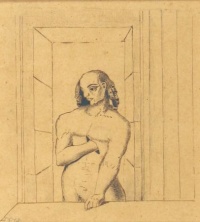
The Heart Has Its Reasons (c.1887) by Odilon Redon, a phrase from the Pensées (1669) by Blaise Pascal
One of my fave Goyas:
The Sleep of Reason Produces Monstersis a 1799 print by Goya from the Caprichos series. It is the image the sleeping artist surrounded by the winged ghoulies and beasties unleashed by unreason.
Season’s greetings
What had started with the reminiscences of a perfectly Breillatian romantic dream …
… ended in Houellebecquian confusion.
Introducing Gaston Burssens (1896 – 1965)
Fabula rasa (1945) by Gaston Burssens (this edition 1964)
I am not much of a fiction reader, nor have I ever been much of a poetry reader. My favorite literature is books about books. Literary criticism or literary theory.
I make exceptions.
The best work I read last year was Michaux’s Plume[1] which happens to be a work of prose poetry, a genre which can be traced most readily to Baudelaire and Poe. A genre which is plotless but nevertheless more concrete than pure poetry.
Saturday I bought the work above. It is worth its price for the introductory notes alone.
Literary critic Paul de Wispelaere reviewed it in the chapter “De groteske wereld en de wereld van de groteske,” in his collection Het Perzische Tapijt (1966). In this essay de Wispelaere juxtaposes Fabula Rasa with the paraprose of Gust Gils, another Flemish writer who wrote in the tradition of the literary grotesque. Fabula Rasa’s Belgian-French counterpart is Plume by Henri Michaux.
While researching this post I also stumbled upon prose by Flanders’ cult poet par excellence Paul Van Ostaijen: De bende van de stronk (The stump gang, 1932, grotesques). I will want a copy of that.
Impressions of Antwerp
Impressions of Antwerp #1
J. M. H. Berckmans (1953– 2008)
Belgian writer J. M. H. Berckmans (1953– 2008) died yesterday. Alternative Flanders mourns.
He was Flanders’ celebrated cult author and the darling bipolar genius of the alternative press (De Morgen and Humo); where he played his role of tortured artist sometimes reluctantly, sometimes willingly.
To me, J. M. H. Berckmans is the literary equivalent of photographer Stephan Vanfleteren[1]. Vanfleteren photographs real life outcasts and misfits of the kind featured in the novels of Berckmans.
Berckmans debuted with Walter Soethoudt in 1977.
Soethoudt was the first Flemish printer to translate and publish Sade, years before Bert Bakker did the same in The Netherlands. He was printer-for-hire with an interesting bibliography: partly risqué[2] and sensational[3][4], partly literary fiction by authors such as Georges Adé, Heere Heeresma, René Gysen, Gust Gils, Freddy de Vree, Claude Krijgelmans, Patrick Conrad, Louis Willems and Jef Geeraerts. These authors also often translated for Soethoudt and published more often than not under pseudonyms for his imprints.
Soethoudt was no Eric Losfeld, but Belgian’s nearest equivalent. Ah, the glorious days of literary mystifications! Read all about them in Soethoudt’s 2008 autobiography titled Uitgevers komen in de hemel [5], edited by Harold Polis, Berckmans’s last publisher.
Adieu Berckmans. I’m sort of sorry I missed your show with Kris Verdonck in March of 2006 at ScheldApen (see news article above), but I’m sure much fun was had by all.
Whither now, anarchitecture?
[Youtube=http://www.youtube.com/watch?v=Q4A5ybTAOWw&]
Some Office Baroque footage, Some footage similar to Office Baroque
Gordon Matta-Clark died thirty years ago today. He stayed in Antwerp for a while in 1977, just before his death, working with Florent Bex, creating Office Baroque, which he called anarchitecture. Pieces of his “building cuts” were sold around the world[1].
I like him, much as I like the near-contemporary and also short-lived Robert Smithson. Whither now, anarchitecture, and other visionary environments?
For those of you who live in Belgium
Ten years of Scheld’Apen celebration/party this Saturday. Scheld’Apen is the most arty nightspot in Antwerp. Arty that is, not arty-farty.
[Youtube=http://uk.youtube.com/watch?v=Fd5zh6JBm5g]
Black Surrealism et al.
A “Jackass” sits atop a tall ladder in front of the Palmetto Theater to promote “Hellzapoppin” starring the comedy team of Olsen and Johnson. The sign on the ladder reads, “I may be a Jackass but I’m not coming down until Helzapoppin’ with Olsen and Johnson opens.” The film was released in 1941 by Universal Pictures. Via here
[Youtube=http://www.youtube.com/watch?v=Bmw7un31UR0&]
A Cadillac commercial by Dylan centered around Bob’s radio show
Spent yesterday evening in the vicinity of the Nachtegalenpark where I listened to The Faces, Nicola Conte‘s newest compilation but most of all to Bob Dylan‘s The Best of Bob Dylan’s Theme Time Radio Hour. Came home and got sick. Slept for more than 15 hours.
Woke up and thought about Black Surrealism, through my first exposure to the work of Slim Gaillard and his role in films such as the 1941 film Hellzapoppin’, of which Ado Kyrou was a fan. Black Surrealism is a concept first put forward by Robin D.G. Kelley in A Poetics of Anticolonialism (1999), although he had overlooked the popular dimension of the concept.
The popular strains of any art form are often forgotten, take for example Ma and Pa Kettle, the American comic duo known for their celebration of the absurd, but much less known and appreciated than comparable films by Jacques Tati (I am referring specifically to Tati’s attack on modernity which was just as prevalent in the Kettle films).
To conclude, a recommendation: if you only buy one CD in 2008, make it Bob Dylan‘s The Best of Bob Dylan’s Theme Time Radio Hour. You’ll enjoy tracks such as Mary Gauthier’s “I Drink”, Dinah Washington’s bawdy “Long Big Sliding Thing” and many more. Trust me.

